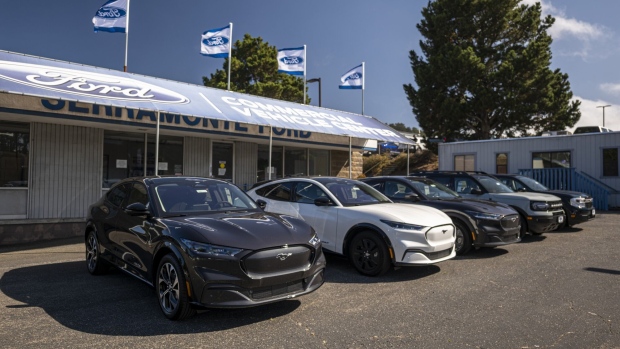Mar 22, 2023
Ford Tiptoes Toward a Big Reveal of Losses From EV Business
, Bloomberg News

(Bloomberg) -- Ford Motor Co.’s Jim Farley was told recently of a survey that found investors overwhelmingly believe legacy automakers can’t be cost competitive with Tesla Inc.
“I’m with them,” the chief executive officer responded at an industry conference last month. “That’s why we split the business.”
Ford’s radical reorganization last year — cleaving the electric, gas-powered and commercial vehicle operations into quasi-independent businesses — aimed to allow more-targeted investments in high-growth areas, showing how committed the automaker is about catching up in the EV market.
The company now is set to take the next step in that process, unveiling an overhauled financial reporting structure for the redesigned company that lays out profit and loss for each business line. Management will host a “teach-in” for analysts and investors Thursday on Wall Street before offering full results in the first-quarter earnings report May 2.
Read more: Ford’s CEO Takes Long Journey to Rebuilding Old Automaker
The new-look balance sheet will give investors a more complete view of Ford’s nascent EV business, including expenses and revenue — and how much money it’s losing.
“Our battery electric vehicle business is a startup buried within Ford,” John Lawler, the automaker’s chief financial officer, said in an interview. “And now we’re going to show the transparency of what that startup is. And like any startup, they’re at a loss in the beginning.”
The purpose of what Ford insiders call a “re-founding” of the 120-year-old company is to chase Tesla’s strong margins, which are three times more than Ford’s highest hopes for its EV business. Farley has also said he wants to command the kind of investor respect that has made Elon Musk’s company the world’s most valuable automaker.
Ford is currently the No. 2 seller of EVs in America, on the strength of its F-150 Lightning plug-in pickup and battery-powered Mustang Mach-E. But it is miles behind Tesla, which controls two-thirds of the US market.
Separating Ford’s EV operations into its own unit — dubbed Model e — is seen as a move toward achieving those ambitions by first bringing financial accountability to the business.
“There’s a lot of curiosity about Model e and how much money it’s losing,” David Whiston, an analyst at Morningstar Inc. in Chicago, said in an interview. “That can then set expectations as to when it can become profitable and to what degree it will be profitable.”
While Ford is increasing visibility into its EV unit, it’s also moving away from the regional results that have been a staple of its financial reporting. It will no longer report figures by geography for North America, Europe, South America and China. That could make it harder to compare the automaker’s performance directly to some peers, such as crosstown rival General Motors Co.
“Whenever you take away transparency, people get grumpy,” Joel Levington, director of credit research for Bloomberg Intelligence, said in an interview. “Here, they’re adding some, but they’re taking away some, too, and people are leaning toward being frustrated about it.”
Ford says the reporting changes are necessary and reflect a new approach to running its business, focusing more on product types than on geographic markets. The company will still provide “color” as necessary to explain region-specific trends, Lawler said.
Breaking out finances by business will also allow Ford to rethink how it allocates resources.
Sharper Focus
“It will sharpen our focus on who gets what capital,” Cathy O’Callaghan, Ford’s controller, said in an interview. “There’ll be an element of competition between the three different segments about who’s going to make the biggest return on that investment.”
The change may give insight into Ford’s progress in getting back to investment-grade credit after its ratings fell to junk in early 2020.
Expectations were building that the upgrade to blue-chip status could happen this year before Ford reported back-to-back quarters of disappointing earnings. S&P Global Ratings auto analyst Nishit Madlani believes that there is a one in three chance Ford is upgraded this year if the company makes needed cost improvements. The automaker’s ability to reach margin and cash-flow targets will be key.
See also: Tesla Exits Junk-Rated World After Moody’s Upgrade
Ford has pledged it will turn its EV losses into an 8% margin on earnings before interest and taxes by 2026. For the full company, Ford is aiming for a 10% Ebit margin by then.
The company currently holds a BB+ rating at S&P and Fitch Ratings, one notch shy of investment grade. Moody’s ranks the company at Ba2, or two steps away from blue-chip status.
Lawler hopes that by revealing results for each of its business units, it will give the rating agencies more to chew on as they assess when to upgrade the automaker.
“Showing how we’re delivering for each of those businesses and how we’re allocating the capital is a plus for them,” he said. “But it’s not up to us. So we need to stay focused on delivering.”
©2023 Bloomberg L.P.





